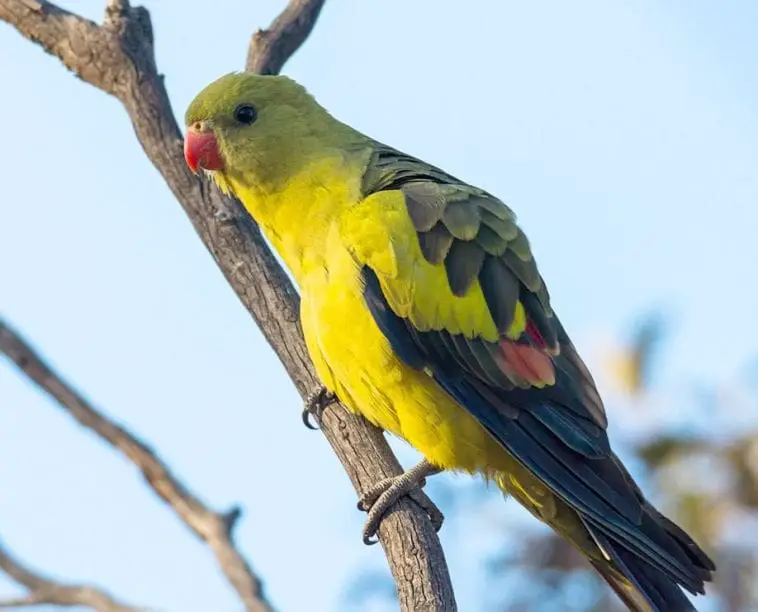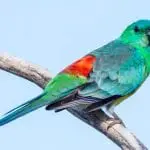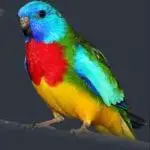Scientific Facts
| Common Name | Regent Parakeets or Regent Parrots |
| Scientific Name | Polytelis Anthopeplus |
| Size | 40 – 45 Cm |
| Life Span | 25 Years |
| Habitat | riparian river redgum habitats, mallee scrub areas, box woodland with cypress pine, orchards and vineyards |
| Country of Origin | Australia |
Even though they are not frequently viewed around, Regent parrots are one of the attractive birds in the parakeet family. With their loving nature and active and pleasant demeanor, these parakeets get incredible companions and friendly pets. With all those desirable qualities develops a fabulous mixture of colors that is bizarre and tremendously impressive. The Regent parakeet is an unparalleled bird and a cherished pet worldwide.
This bird, generally popular as the Regent Parrot or Regent Parakeet, but it is likewise regarded as the Rock Pebble along with the Marlock Parakeet, Black-tailed Parakeet, and the Smoker. It has been remarked that the birds from the eastern part of Australia are more eccentric than those in the western area.
Physical Description
These intermediate birds attain a standard measure of approximately 40 centimeters (16 inches). Contrary to some other parrots, they have rounded plump figures and a moderately shrunk tail. They likewise hold a well-defined bill – sharp and small, and comparable to the Budgerigar parrot. Males and females can be identified by their sparse color variations, and with some training, you will be capable to effortlessly differentiate them individually.


You are compelled to become smitten with the elegant appearance of these parrots. The males possess natural yellow feathers with a green-yellow head and neck, while the female is primarily a more olive-green with a deep olive-yellow on the crown and chest. The rear on both sexes is deep olive green, and there is a red line beyond the core of the appendages. The outer plumages of the wings are bluish-black and yellow below. The tail is likewise a blue-black, but the female possesses the dark olive-green plumages under topped with a rose-pink, and the sides are marginated. The legs are gray, and the beak is a coral color.
The youngsters are comparable to the females although the young males will be extra yellow. They will acquire their complete pigmentation at roughly 14 months of age.
Geographical Range
The eastern subspecies is confined to regions around the New South Wales, the Murray River in South Australia, and the Victoria.
In NSW, it befalls near the Murray River downstream of Tooleybuc (however, there are some reports between the South Australian and Mildura perimeter), the Wakool River downstream of Kyalite, and the Murrumbidgee River promptly upstream from the intersection with the Murray River and neighboring regions of mallee. There are separated documents along the Darling River as distant north as Menindee, but at this degree, the species has not been verified to reproduce along this river. The designate subspecies transpire in south-western Western Australia.
Subspecies
One subspecies of this bird, Polytelis anthopeplus anthopeplus, dwell in plentiful quantities in the southwestern section of the mainland, favoring domains compact with eucalyptus or other trees. Southeastern Australia is a place to Polytelis anthopeplus monarchoides, another subspecies, which is on the endangered record. Merely around 400 couples remain in regions with a constant climate that is packed with shrubs and thicket. Destroyed by dehydration, competition, and humans, the southeastern subspecies are now preserved, and struggles are being performed to raise their quantities.
Habitat
The species dens within River Red Gum woodlands across the lower Murrumbidgee Rivers and Murray Wakool, and possibly the Darling River downstream of Pooncarie. General cradle woods are great, developed strong trees with many spouts (though lifeless trees are employed), and are commonly found adjacent to a river.
Principal hunting environment is mallee forests, though hunting likewise transpires in riverine thickets and groves. Mallee forest inside 12 miles of dwelling sections is a dangerous hunting territory for reproducing birds.
They may employ cereal stocks and will feast on the scattered seed. It is alleged to be a bother in almond farms.
Birds travel between the fluvial dwelling territory and hunting sections along passageways of natural vegetation.
Common Behavior
Substantially, the Regent parrots are a tame and loving bird. They will build a connection at an early age, and as they learn faith, they will present the comical and more dynamic side of their character. With enough social interaction, several playthings, and a free room, you will immediately recognize that a comfortable and sturdy Regent parakeet is a warm and gentle pet parrot. Their humble response gives them adequately for companion parrots and aviaries.
Speech and Sounds
These dynamic small parrots have a general inclination to be detected. They are blatant, and as well as, a particular harsh chirp or tweet, they will frequently acquire several terms to imitate. Besides those, they readily imitate typical home noises – phones, alarms, and doorbells. To practice them, you can begin with whistles and proceed from there. You’ll be amazed at how suddenly they study. But in common, home environments might not be the most desirable option when your parrots become talkative.
Diet and Feeding Habits
Natural Diet: Though hunting likewise transpires in riverine woodlands and timbers, their main hunting territory is mallee groves. They may use seed products and will supply on scattered maize.
Confined Feeding: Regent Parrots flourish on diced blends for huge parrots. Various vegetables and fruits (especially apples, carrots, and oranges), along with green food (spinach, chickweed, and dandelion, etc.) rose-hips, must be a component of their nutrition. A high-quality grain mix comprising of various millets, canary seed, oats, wheat, sunflower, and weed grains must be their core diet. They likewise relish a small assortment of insects, egg food, and sprouting seeds. Bug mushy meat is especially necessary during the breeding period and when nursing the juvenile. As with all birds, they require a quick stock of granular grit to help in digestion.
Reproduction and Life Cycle
The Regent Parrot or Regent Parakeet will immediately reproduce and will bear one herd per year. In the native, they create their dens in great holes down in the major piece of a tree.
The female hatches 3-8 embryos for nearly 21 days. Throughout this stage, she occasionally leaves from the cradle, if anywise, and is served by the male. When the young have born, they are attended over both the male and female. During this session, they can be filled numerous points their standard share of the meal, which they immediately carry to their junior. The newborn starts to travel at roughly 5 weeks. Reproductive development is attained at about 2 years of age.
As the shipping-in of these wonderful parrots is obstructed by the Australian jurisdiction, many think that the species should be held from hybridizing to guarantee their restoration, there will be no more real species born into this realm. Though, they will simply interbreed and have been cross-breed with the Crimson-winged Parrot, Princess Parrot, and the Superb Parrot.
Color modifications have likewise been accomplished. There is a yellow-backed variety in Europe and a red variation in Australia.
How to Breed
Breeders must be held in twos instead of flocks since they might fight with one another, though couples or single have been retained pleasantly with other tamed species like cockatiels.
In their original environment, the Regents Parrot commonly dwells in great, older strong trees with several streams (though stagnant trees are employed) neighboring a river.
The female broods 3-7 embryos for nearly 20 to 23 days. The initial clasp is periodically barren as female is frequently in condition before the male.
Amidst the incubation stage, the female occasionally leaves from the cradle, if at all, and is served by the male. When juveniles have born, they are heeded by the parents. During this stage, they can be filled numerous occasions their common serving of feed, which they eagerly move to their junior. The junior start to circumnavigate at nearly 35 days and are self-sufficient at 50 days. Genitive fitness is stood at approximately 2 years of age. The Regents Parrot can reproduce twice a year. It’s, nevertheless, most satisfying to transfer the junior from the initial breeding on the start of a new breeding series.
The approved dwelling home is a remnant with 8 ins (20 cm) internal width and at least 24 ins (60 cm) low that is installed cornerwise. By contrast, a cradle crate can be given: 7 x 7 x 24 ins (18 x 18 x 60 cm) with access opening 3 ins (8 cm) in diameter.
Pet Care

Housing:
The Regent Parrot serves from a huge enclosure to urge them to drive and to train. A little parrot coop might not be substantial, granted the rod distance wasn’t too broad. Smallest area for a single bird might be 91 cm by 60 cm by 91 cm, and larger might be more desirable because these birds lead to training by circumnavigating, instead of fiddling with stuff or climbing. Though, the generality of couples or flocks is unquestionably housed in custom-made aviaries, to boast these birds to supremacy and to enable them to travel. They serve to consume plenty of time on the ground, so take responsibility to render an underlayer that is efficiently washed, to limit the development of infections or other conditions.
Maintenance:
The fundamental enclosure consideration incorporates regular cleansing of the food and water vessels. Hebdomadal, you must clean all the roosts and messy playthings, and the platform must be soaked roughly every other week. A complete rinsing and sanitizing of an aviary must be prepared annually, replenishing anything that wants to be cleansed, such as perches, old dishes, and toys.
Health and Common Conditions
Admitting they might seem delicate and modest at an initial glimpse, these parrots are tough and strong. This is particularly accurate when they are granted the required care and attention. Bear in mind that Regent parakeets are skilled flyers and need a load of open area. Besides a large enclosure, they want the option of wandering throughout the residence. They will examine, pursue you around, and travel as greatly as they desire. This activity is a foundation for excellent wellness and satisfaction.
Availability
Regent Parakeets or Regent Parrots are occasionally available at pet stores or from breeders.

Conservation
Threats
- Birds may serve on roadsides and therefore be in danger of being hit by transportations.
- Both breeding and foraging territory is threatened by growing groundwater, with regions upstream of Euston Weir especially affected.
- Competition for nest holes with wild honeybees can happen in the abandonment of den sites.
- Grazing has the potential to decrease the degree of the foraging environment.
- Harvesting of mallee for charcoal may decrease the appropriateness of these places as foraging habitat.
- Harvesting of river red gum has the potential to result in the loss of nest trees and limit the recruitment of new nest trees.
- Illegal egg accumulating or extraction of chicks from retreats may damage nest hollows and can affect populations through the loss or death of individual birds. However, the current level of this threat in NSW is currently unknown.
- Lack of environmental water driving environment degeneration via modification in the position and recruitment of nest-trees (River Red-gums).
- Regent Parrots have been killed in almond orchards in Victoria and South Australia because of destruction produced to growing crops. Although almond production is relatively small in NSW, the birds may be from NSW breeding colonies.
- The impact of fire management on this species is unknown, but as fire is an important component in mallee ecosystems, inappropriate fire regimes may likely impact on foraging habitat.
- The main threat is the destruction of the mallee forest inside 20 kilometers of the Murray River.
- The parrots demand good connectivity of protected territory within the breeding habitat and between breeding and foraging habitat; currently, the scene is highly fragmented, and hence, only several narrow migration passageways exist.
Status
The eastern subspecies (P. anthopeplus monarchoides) is classified as Vulnerable under the Australian Environment Protection and Biodiversity Conservation Act 1999, while the western subspecies (P. anthopeplus anthopeplus) is registered as Lower Risk or Least Concern. A restoration project for the subspecies was written in 2011.
FAQs
How long do regent parrots live?
There is no written report on the life prospect of the Parrot, but anecdotal data implies that some individuals may exist for 25 years or more
What do regent parrots eat?
The Regent Parrot eats grains of weeds and bushes and cereal crops, particularly wheat. It likewise eats lerps, psyllids, insect larvae, and flowers and buds.
What is a female parrot called?
A female parrot is named: hen.
What is a male parrot called?
A male parrot is called a boar.
Can female parrots lay eggs without a male?
In native birds and breeding birds, egg-laying is a common, periodically method. However, female pet birds can likewise produce eggs, even without the attendance of a male. Such eggs are infertile and will not hatch, even if incubated.
How do parrots mate?
Most species of parrots are monogamous, sticking with merely one breeding companion for their whole lives. The breeding partner stays together even during the nonbreeding period. A courtship arrangement is made by the males for the females before such a bond between the breeding pair is formed.



